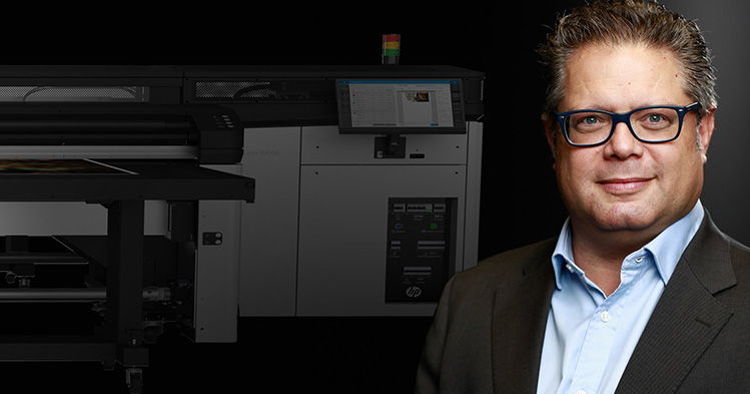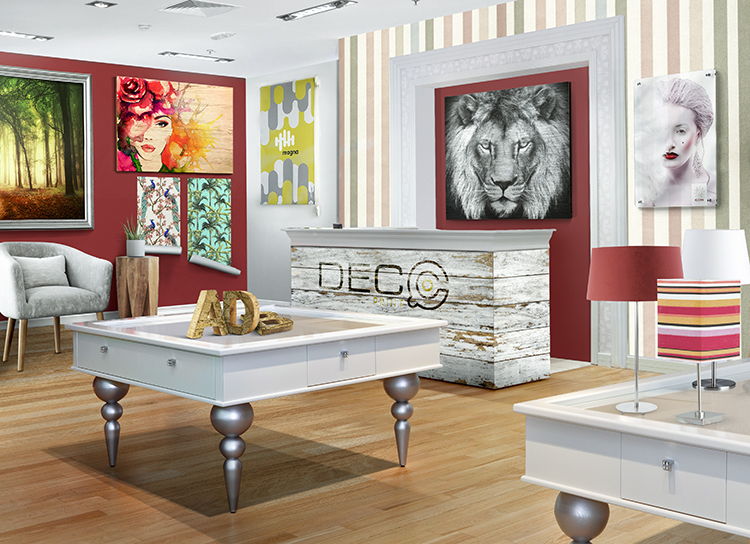Interior design, in the home and the workplace – as well as in public facing areas including healthcare and hospitality – can be customised and personalised with digital print in an effective, dynamic and unprecedented way.
Let’s get right into the numbers: according to data from Kao Collins, the digital wallpaper market in 2017 was valued at $2.33 billion, with a prediction of growth to over $13 billion by 2025, representing a compound annual growth rate (CAGR) of over 24%.
Certainly, it’s our belief that digital print in-home is at a tipping point and – should we hit said tipping point – growth could dwarf the above projections.
Beyond home wallcoverings and soft furnishing there is similar expectation for significant growth in the industrial and commercial space. Research business Smithers Pira has previously suggested that the decorative printing of items – ranging from higher volumes of bespoke furniture through to production of laminated flooring – could see the ‘Future of Decorative Printing to 2023’ balloon in to a $19 billion commercial market.
Taking the above into account, we thought it was the ideal time to investigate the topic of personalised interior décor printing in greater detail, so we reached out to our friend Terry Raghunath at HP to see if we could get answers to some of our most pressing questions. Terry will also be hosting a webinar on the subject on Jan. 14 at 9 a.m. UK time/10 a.m. CET time (click here to sign up).
Terry, can you tell us a little about the opportunity that exists in décor and interior design?
Interior Décor and DIY has grown very healthily in 2020 – in spite of the current pandemic – and there are no signs that it will stop. Many of us have invested in our homes and wellness, cocooning and general re-purposing of spaces has been on the agenda for us all. Now we’ve scratched the surface and seen the potential, and we’re more receptive to the digitally printed customisation opportunities than at any time previously.
Furthermore, today’s generation now genuinely believes that their homes (and workspaces) are a reflection of their personalities. They have a heightened awareness of home fashion trends through engagement on visual social platforms such as Pinterest and Instagram, and through use of home décor apps such as Homestyler, BrightNest and Houzz.
Just a few years ago, luxury in interior design meant high end fittings and materials. Not anymore. Now, the perception of luxury in decor is less about “things” and “stuff” and more about unique “experiences” and “spaces” such as spa bathrooms and in-home movie theatres. People want uniqueness; a look that no one else has in their home.
The office and commercial environments have seen significant change too. Thanks to digital print, branding, motivational messages and much more can be cost-effectively added to previously blank surfaces such as walls, partitions, blinds and glass.
These trends are opening up a huge market for digital decor products. With PVC-free wallcoverings and fabrics, designers can print an almost unlimited array of one-of-a-kind murals and wall effects, branded upholstery, and complementary soft furnishings.
What advice would you give to a PSP looking to pivot their business into the décor market?
What I would say firstly is this: whatever moves you are considering next, please talk to HP and our partners. We can discuss your ideas with you and assist you with market know-how and well-researched insight to help you make the right choices. It’s also vital to know what your customers want, and to partner with the right suppliers in order to tap into their expertise.
In terms of general pointers, I’d suggest some of the following:
• Select your target customers – potential market segments exist, through collaboration or direct sales, in: hospitality (restaurants, hotels, casinos, spas); corporate offices and working environments; healthcare; education; retail; airports; local government; and home owners.
• Is it viable to collaborate with the right partners? Combining your print expertise with a talented artist or pattern designer could be the key to unlock a great new business.
• Decide which products you would like to focus on selling. Wallcoverings, wall murals, ceiling decoration, canvases, wall decals, window blinds, wrapping objects/gifts, personalised gifts? The list is pretty much endless.
• Create a new brand and a new website that reflects your expertise in interior decoration. A new brand because the terms ‘sign’ or ‘print’ (or your print-room plant list) are not going to resonate with customers who are looking for decoration products.
• Create and share your visually most impressive design and print work. Promote it using social media. If it is good enough it will get noticed.
• Be confident and approach the idea with enthusiasm. The business is there. It won’t happen overnight, but with perseverance it will happen – and the trends and the numbers say so:
• 78% of the interior designers who have used digital wallcovering in their projects reported that they are ‘very’ to ‘extremely satisfied’.
• 61% of the interior decorators have specified more digital wallcovering products compared to two years ago.
How important is e-commerce to the decor market?
E-commerce has seen, and will continue to see, incredible exponential growth. There has been a surge recently in personalised goods and in handmade and bespoke products and crafts. Local artists and crafters are selling to local customers in unprecedented numbers through online sales platforms such as Etsy, Amazon Handmade, Not on the High Street and Shopify.
Thanks to digital print, pattern and surface designers who in the past would have struggled to print a short run of wallpaper designs, or a handful of cushions, can now find many ways to get their creations printed and shipped – and use these e-commerce platforms to build an engaged and eager audience.
Is there also an opportunity for designers to bring this type of print production in-house?
‘Yes’ is the simple answer. HP Latex odourless prints that can be printed safely in an enclosed office or even at home, and the print produced can be installed in locations where solvent and UV-curable sometimes cannot – particularly important when you are considering wallcoverings, décor and soft furnishing for use in domestic settings, schools, hospitals etc.
Perhaps the biggest single advantage of digital over analogue is the ability to print when required on-demand with minimal setup and tooling costs. This enables print companies of all sizes, even those working from a home office, to become more agile and more sustainable by default. Digital print has the potential to bring significant advantages, with less waste and lower costs.
Ultimately HP Latex technology is ideally suited to the task, with unique benefits for your business.
Let’s wrap up with a single takeaway action; what does a PSP do right now, today, to start the ball rolling?
On January 14th at 9:00AM UK time, HP will host a free-to-attend webinar titled ‘Explore the possibilities of Interior Décor Printing.’
Whatever other important decisions you make for your business today, I’d encourage you to also make the decision right now to join me and a number of other industry experts, interior designers and HP customers to learn more about the endless possibilities in interior décor.
Click here to find out more and register.




